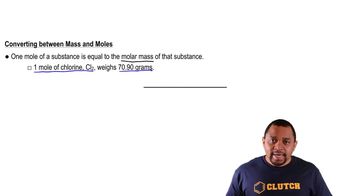Here are the essential concepts you must grasp in order to answer the question correctly.
Equilibrium Constant (Kc)
The equilibrium constant, Kc, quantifies the ratio of the concentrations of products to reactants at equilibrium for a given reaction at a specific temperature. For the reaction Br2(g) ⇌ 2 Br(g), Kc = [Br]^2 / [Br2]. A low Kc value, such as 1.04 * 10^-3, indicates that at equilibrium, the concentration of reactants (Br2) is much higher than that of the products (Br).
Recommended video:
Equilibrium Constant Expressions
Molar Mass and Mass to Moles Conversion
To find the number of moles from a given mass, the molar mass of the substance is used. For Br2, the molar mass is approximately 159.8 g/mol. By dividing the mass of Br2 (0.245 g) by its molar mass, we can determine the number of moles of Br2 present in the vessel, which is essential for calculating the moles of Br produced at equilibrium.
Recommended video:
Mass and Moles Conversion
Stoichiometry in Chemical Reactions
Stoichiometry involves the quantitative relationships between reactants and products in a chemical reaction. In the reaction Br2(g) ⇌ 2 Br(g), the stoichiometric coefficients indicate that one mole of Br2 produces two moles of Br. This relationship is crucial for determining the amount of Br(g) formed based on the amount of Br2(g) present at equilibrium.
Recommended video:




